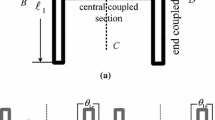Abstract
The integral equations technique based on a three dimensional finite element method is applied as a quick and accurate analysis tool for the design of microwave passband filters. A three resonator H-plane bandpass filters with the various shapes of cavities and the irises are analyzed with this method in a single step and for only one mode, take into account all the electromagnetic effects. Consequently, it consumes less memory and CPU time.
We propose also to study the same filters filled by homogeneous high dielectric material (ετ = 9.6) for Both resonator and coupling section.
All these numerical results have been validated through a comparison with the results available in the scientific literature.
Similar content being viewed by others
References
(1) Smain Amari, Jens Bornemann and Rüdiger Valdieck, “Fast and accurate analysis of waveguide filters by the coupled integral equations technique”, IEEE Trans. Microwave Theory Tech, Vol.45, No.9, SEPTEMBER 1997.
(2) Vladimir A. Labay, Jens Bornemann, Smain Amari and M. Damaschke, “Direct coupled waveguide filters for the lower Gigahertz frequency range,” International Journal of RF and Microwave CAE 12:217–225, 2002.
(3) Amr Abdelmonem, Ji-Fuh Liang, Hui-Wen Yao, and Kawthar A. Zaki, “Full-wave design of spurious free D.R. TE Mode band pass filters”, IEEE Trans. Microwave Theory Tech, Vol.43, No.4, 1995.
(4) J. Uher, J. Bornemann, and U. Rosenberg, “Waveguide Components for Antenna Feed Systems”: Theory and CAD. Norwood, MA: Artech House, 1993.
(5) Jan Michael Reiter, Fritz Arndt, “Rigorous analysis of arbitrarily shaped H and E plane discontinuities in rectangular waveguides by a full-wave boundary contour mode-matching method," IEEE Trans. Microwave Theory Tech, Vol.43, No4, April 1995.
(6) P.Guillot, «Contribution à l'étude des discontinuités en guides métalliques. Application aux transistors et aux filtres», Doctorat de l'institut national polytechnique de Toulouse, Novembre 1994.
(7) K. Nouri, M. Feham and N. Benahmed, «Caractérisation des filtres micro-ondes à discontinuités en guides d'ondes métalliques», SETIT 2004 International Conference: Sciences of Electronic, Technologies of Information and Telecommunications, March. 15–20, 2004 — TUNISIA.
(8) Guiseppe Pelosi, Stefano Selleri, Roberto Coccioli “Quick finite elements for electromagnetic waves,” Artech House Boston. London, 1998.
(9) K. Nouri and M. Feham, “Generalized modal scattering matrix of bandpass filters using ridged waveguides”, International Journal of Infrared and Millimeter Waves, Vol. 26, No. 6, June 2005.
Author information
Authors and Affiliations
Rights and permissions
About this article
Cite this article
Nouri, K., Feham, M. & Dali, S. Various Shapes of 3 D Resonators Pass-Band Filters. Int J Infrared Milli Waves 26, 1727–1739 (2005). https://doi.org/10.1007/s10762-005-0293-4
Received:
Published:
Issue Date:
DOI: https://doi.org/10.1007/s10762-005-0293-4



